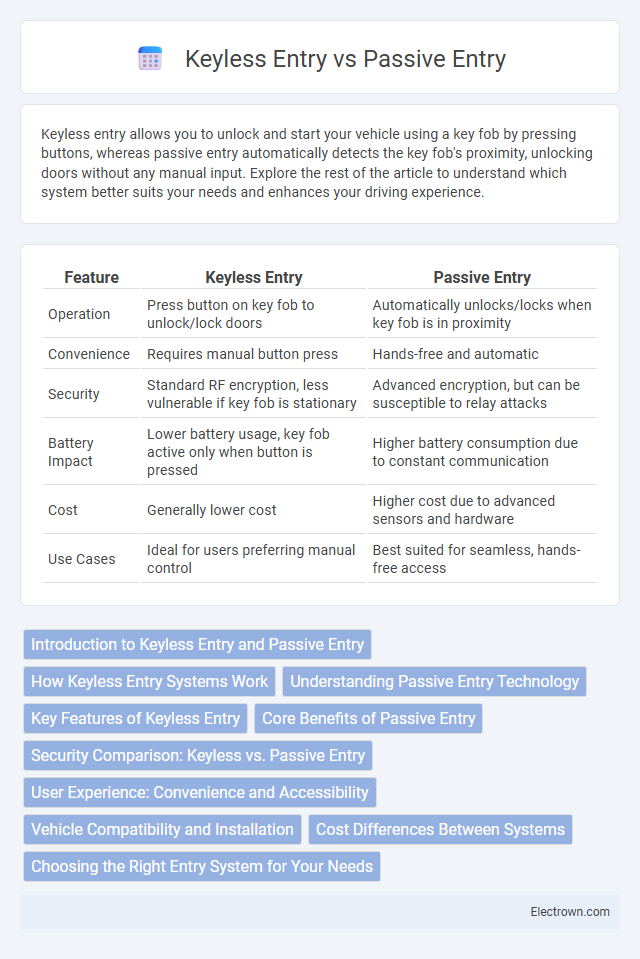Keyless entry allows you to unlock and start your vehicle using a key fob by pressing buttons, whereas passive entry automatically detects the key fob's proximity, unlocking doors without any manual input. Explore the rest of the article to understand which system better suits your needs and enhances your driving experience.
Table of Comparison
| Feature | Keyless Entry | Passive Entry |
|---|---|---|
| Operation | Press button on key fob to unlock/lock doors | Automatically unlocks/locks when key fob is in proximity |
| Convenience | Requires manual button press | Hands-free and automatic |
| Security | Standard RF encryption, less vulnerable if key fob is stationary | Advanced encryption, but can be susceptible to relay attacks |
| Battery Impact | Lower battery usage, key fob active only when button is pressed | Higher battery consumption due to constant communication |
| Cost | Generally lower cost | Higher cost due to advanced sensors and hardware |
| Use Cases | Ideal for users preferring manual control | Best suited for seamless, hands-free access |
Introduction to Keyless Entry and Passive Entry
Keyless entry systems use a remote or keypad to unlock your vehicle without inserting a physical key, enhancing convenience and security. Passive entry allows your car to detect the proximity of a key fob, automatically unlocking doors as you approach without pressing any buttons. Both technologies improve vehicle access, with passive entry providing a seamless, hands-free experience.
How Keyless Entry Systems Work
Keyless entry systems operate by transmitting a coded radio signal from the key fob to the vehicle's receiver, allowing doors to unlock when the button is pressed. Passive entry systems automatically detect the proximity of the key fob and unlock the doors without any button press, using low-frequency signals to communicate continuously. These technologies rely on encrypted communication to enhance security and prevent unauthorized access.
Understanding Passive Entry Technology
Passive entry technology enables seamless access to your vehicle without physically using a key or pressing buttons, relying on proximity sensors that detect an authorized key fob nearby. Unlike traditional keyless entry requiring manual unlocking, passive entry automatically unlocks the doors as you approach, enhancing convenience and security. This system improves user experience by minimizing interaction while maintaining encrypted communication to prevent unauthorized access.
Key Features of Keyless Entry
Keyless entry systems provide convenience by allowing you to unlock your vehicle using a remote fob or smartphone app without inserting a physical key. Key features include remote locking and unlocking, panic alarm activation, and sometimes remote start functionality to pre-condition the vehicle's climate. These systems enhance security by requiring signal encryption to prevent unauthorized access.
Core Benefits of Passive Entry
Passive entry systems automatically unlock your vehicle as you approach, enhancing convenience by eliminating the need to physically use a key or press a button. These systems improve security by enabling encrypted communication between the key fob and the car, reducing the risk of unauthorized access. With passive entry, your experience is seamless, allowing you to focus on your activities without fumbling for keys.
Security Comparison: Keyless vs. Passive Entry
Keyless entry systems often require you to press a button on a fob to unlock your vehicle, which can be vulnerable to relay attacks that intercept signals. Passive entry enhances security by automatically detecting your presence through encrypted signals without any button press, reducing the risk of signal interception. Your car's security improves with passive entry, as it continuously authenticates the key fob's proximity before granting access, offering superior protection compared to traditional keyless setups.
User Experience: Convenience and Accessibility
Keyless entry offers straightforward convenience by requiring users to press a button to lock or unlock their vehicle, enhancing control over access. Passive entry elevates accessibility by automatically detecting your key fob nearby, allowing seamless unlocking without any physical interaction, improving ease and speed. Your experience benefits significantly from these technologies, as they minimize effort and maximize security when approaching or exiting your vehicle.
Vehicle Compatibility and Installation
Keyless entry systems are widely compatible with various vehicle models and typically require professional installation involving wiring and integration with your car's door lock mechanism. Passive entry systems offer enhanced convenience by automatically unlocking your vehicle when the key fob is nearby, but their installation demands advanced programming and vehicle-specific modules to ensure compatibility. Understanding your vehicle's make and model is crucial for selecting the right system that balances seamless installation and optimal functionality.
Cost Differences Between Systems
Keyless entry systems typically incur lower installation costs, as they rely on remote key fobs requiring manual button presses, while passive entry systems involve advanced sensors and antennas that automatically unlock the vehicle when you approach, leading to higher expenses. Maintenance for passive entry systems can also be more costly due to the complexity of the technology and potential sensor repairs. Choosing between these systems depends on your budget and preference for convenience versus cost efficiency.
Choosing the Right Entry System for Your Needs
Keyless entry systems require you to manually press a button on the fob to unlock your vehicle, offering control and security for users who prefer active engagement. Passive entry systems automatically unlock the doors when the key fob is detected nearby, providing seamless convenience without needing to press any buttons. Evaluating your lifestyle and preferences will help determine whether the manual control of keyless entry or the effortless access of passive entry best matches your needs and enhances your daily routine.
Keyless entry vs Passive entry Infographic

 electrown.com
electrown.com